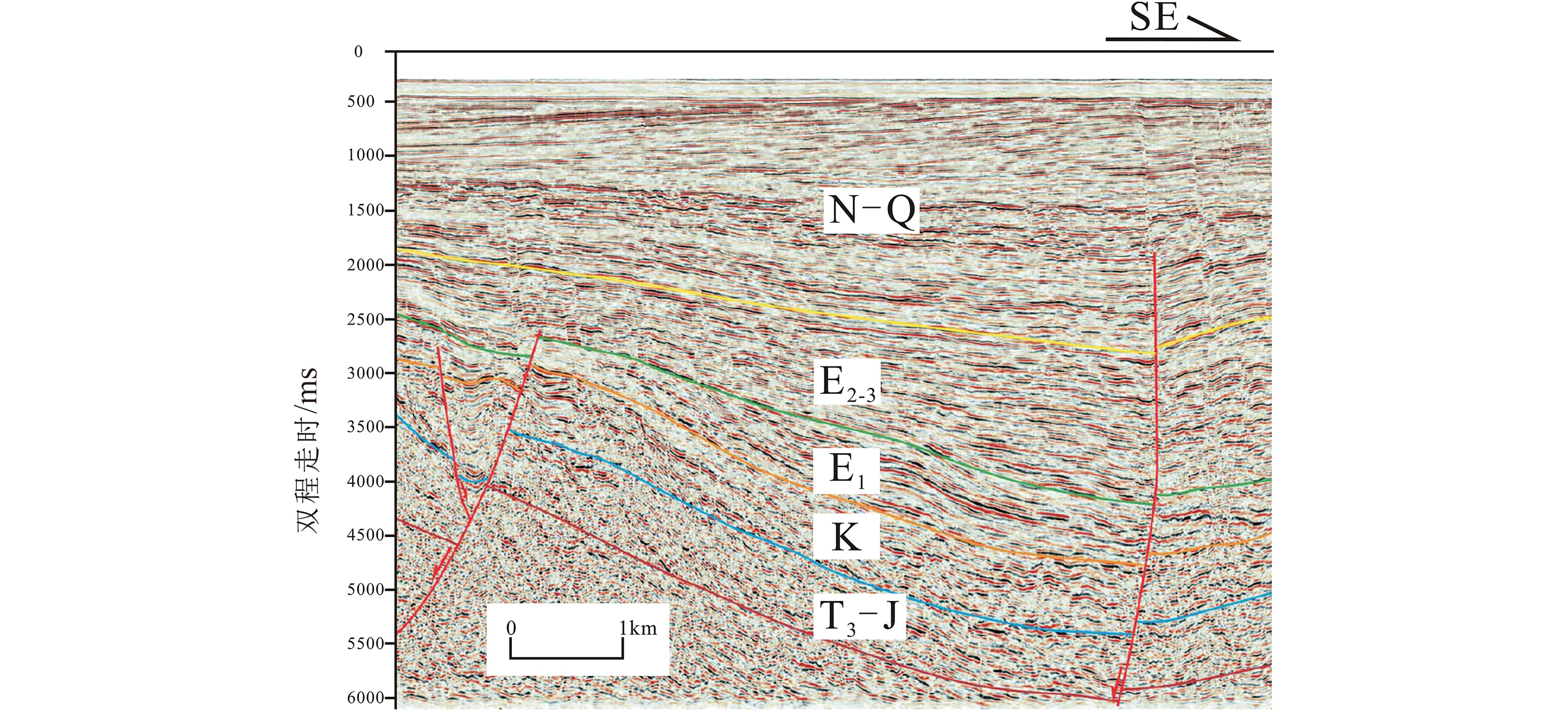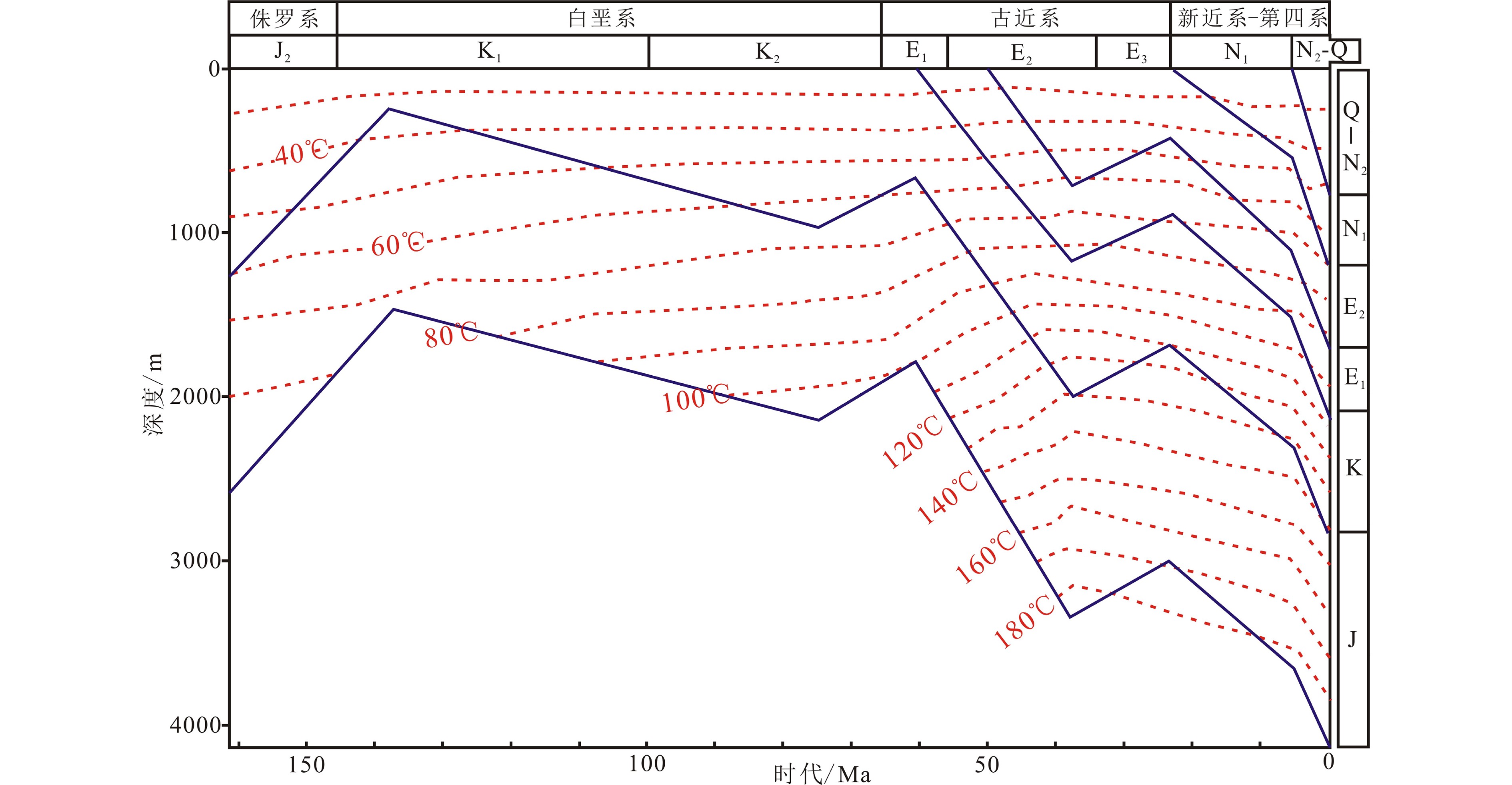Cretaceous hydrocarbon accumulation conditions in the southeastern East China Sea Shelf Basin
-
摘要: 目前东海陆架盆地的勘探形势良好,在新生界陆续发现多个油气田,但在盆地中生界尚未有大的勘探突破。为提高油气勘探效率,利用含油气系统的理论与方法对研究区白垩系油气成藏要素及成藏作用进行了分析,总结出了研究区油气成藏模式。结果表明:研究区白垩系烃源岩主要发育在基隆凹陷,岩性推测为海湾相暗色泥岩,有机质丰度高,类型好;储层主要为中―新生代砂岩,储集空间主要为原生孔隙和次生裂缝,白垩系砂岩整体为中孔中渗储层,新生界储集性能较好,并以始新统平湖组和渐新统花港组砂岩最为重要;中新生代盖层主要为泥岩,发育两套生储盖组合;受构造演化所控制,基隆凹陷可能经历了白垩纪晚期、古近纪、新近纪―至今3次生烃,其他地区只经历了后两次生烃;油气主要是通过优势输导砂体、不整合面、断裂和裂缝所组成的输导体系向周围圈闭运移;东海陆架东南部白垩系油气主要存在3种油气藏类型。本次研究结果可以为东海陆架盆地东南部白垩系的油气资源评估提供依据。Abstract: The exploration of oil and gas is very successful in the East China Sea Shelf Basin up to present. A number of oil and gas fields have been discovered in the Cenozoic, but no significant breakthrough has been made in the Mesozoic so far in this basin. In order to improve the efficiency of oil and gas exploration, we analyzed the Cretaceous hydrocarbon accumulation factors in the study area by using the theories and methods of petroleum system, which are summarized into a hydrocarbon accumulation model for the study area. The results show that the Cretaceous source rocks in the study area are mainly deposited in the Jilong Sag, dominated by dark mudstone of bay facies with high organic matter abundance as a good type of source rock. The reservoirs are mainly consisting of Mesozoic-Cenozoic sandstone, with primary pore and secondary fractures as the main reservoir space, and the Mesozoic sandstone has moderate porosity and permeability in general. The Cenozoic reservoirs have good performance, in which the sandstone of the Pinghu Formation in Eocene and Huagang Formation in Oligocene are the most important ones. The Mesozoic and Cenozoic caprocks are mainly mudstone. There are two sets of source-reservoir-cap assemblages. Controlled by tectonic evolution, the Jilong Sag may have experienced three periods of hydrocarbon generation, i.e late Cretaceous, Paleogene and Neogene-to-present, while other areas have only experienced two. Hydrocarbon conducting system is composed of sand bodies, unconformities, faults and fractures. There are mainly three types of hydrocarbon models in the Cretaceous of the southeastern East China Sea Shelf Basin. The results of this study have provided a basis for the evaluation of the Cretaceous oil and gas resources in the southeastern part of the East China Sea Shelf Basin.
-
1994年Magoon和Dow提出了含油气系统的完整概念:含油气系统包含成熟的烃源岩及所有的已形成的油气藏,并包括油气藏形成时必不可少的所有地质要素和地质作用以及合适的时空配置[1]。成藏要素包括烃源岩、储集层、盖层和上覆岩层,成藏作用包括圈闭的形成和油气的生成—运移—聚集。只有成藏要素和成藏作用合理的时空匹配才能使烃源岩生成的油气在圈闭当中聚集成藏。含油气系统理论和方法的提出为油气成藏研究注入了新思维。经过20多年的丰富和发展,含油气系统己经形成了一套相对完整的理论和方法体系。它从成熟烃源岩及与此有关的油气藏入手,系统研究油气藏形成时必不可少的地质要素和地质作用,提供了一个综合分析和预测油气成藏的思路,可以有效地降低勘探风险。针对中国境内的沉积盆地大部分都是叠合盆地这种特点,大量学者进行了深入研究,并且提出了很多新理论,有效地指导了叠合盆地的油气勘探[2-7]。
东海陆架盆地是我国海域的一个大型中—新生代叠合含油气盆地,中生代以来经历了多期构造运动,地质条件复杂[8-13]。东海陆架盆地油气勘探分为2个阶段,2005年以前勘探主要集中在新生界,之后随着地震采集和处理技术的提高,中生界得到了良好的揭示,油气勘探重点也逐渐向深层倾斜[12]。前人对东海陆架盆地开展了多方面的研究,在盆地构造格局、盆地演化、中生代原型盆地、盆地形成的动力机制、圈闭发育、储层特征等方面获得了很多的成果[8-9, 11-18],在此基础上认为东海陆架地区中生代盆地具有良好的油气地质条件,是我国重要的油气勘探战略接替区之一[12, 14, 19]。但是迄今为止,尚未有学者对东海陆架区中南部白垩系油气成藏条件开展过系统研究和评价,制约了对研究区油气资源潜力的认识。本次研究在前人研究成果的基础上,开展东海陆架盆地中南部白垩系油气成藏要素分析,深入研究其油气成藏条件,建立油气成藏模式,进而为研究区的油气资源评估提供依据。
1. 区域地质背景
中生代是中国东部最重要的构造变格时期,经历了三叠纪时期的印支构造域向侏罗纪以来的滨太平洋构造域的演变过程,构造应力场多次转换,构造特征和盆地演化过程非常复杂。东海陆架盆地东侧为钓鱼岛隆褶带,南接台西盆地,西邻浙闽隆起区,北部以隆起与南黄海盆地相隔。受NE―NNE向断裂控制,东海陆架盆地具有北东分带、北西分块的分布特征。白垩纪东海陆架中南部总体为断陷沉积,从西到东发育有瓯江凹陷带、雁荡低凸起带、闽江斜坡带、台北转折带、基隆凹陷带等5个构造单元,白垩系在这5个单元中均有不同程度的分布(图1)。区内各断陷呈东断西超的箕状,表现为单断或复合型断陷,沉积中心位于断裂下降盘。
2. 白垩系油气成藏要素
2.1 烃源岩发育特征
东海南部白垩系广泛分布,闽江凹陷FZ13和FZ10井揭示白垩系主要为红色陆相碎屑岩沉积。这两口井在侏罗纪、早白垩世处于沉积的相对高部位,有机质含量相对较低。但是这两口井所在位置的沉积特征和有机质丰度代表不了基隆凹陷。通过区域地质对比、地震资料解释,以及地震相和沉积相综合分析发现,从雁荡低凸起至基隆凹陷总体表现为一斜坡,侏罗纪至早白垩世的沉积是由东向西超覆直致尖灭,基隆凹陷是该区沉降和沉积中心。白垩系分布范围约有8 000 km2,地层厚度1 000~4 000 m。通过钻井和地震资料的综合分析,推测研究区自西北向东南方向依次发育陆相河流―湖泊相、海陆过渡相、半深海相沉积。其中陆相和海陆过渡相主要发育在西部,而海相地层主要分布在东部。基隆凹陷白垩系在地震剖面上主要为中强振幅较连续—连续平行反射相,反映地层沉积稳定,为海湾相、半深海相沉积(图2)。通过对已有的白垩系泥岩地球化学数据统计后发现,陆相泥岩总有机碳含量一般小于0.5%,主要为Ⅲ型干酪根;海陆交互相泥岩主要分布在0.5%~0.7%,以Ⅲ型干酪根为主,其次为Ⅱ型;海湾相和半深海相泥岩主要分布在0.6%~1.5%,以Ⅰ型干酪根为主,其次为Ⅱ型。总体来看海湾相和半深海相泥岩有机质含量高,其次是海陆交互相,陆相泥岩最差。
虽然在基隆凹陷没有钻井钻遇该套地层,但在该凹陷的南部地区有多口井钻遇,如YCC井揭示下白垩统715.6 m,观音隆起上CAC井钻遇400 m白垩系。澎湖—北港隆起的WH-1井揭示白垩系厚度超过1 000 m,其中深灰色—黑色页岩厚约500 m,另夹有87 m鲕粒灰岩。通过与这些相邻地区白垩系地层对比,并结合沉积相分析结果,认为基隆凹陷发育厚层优质烃源岩。
从白垩系暗色泥岩等厚图上可以看出(图3),白垩系暗色泥岩呈北东向展布。暗色泥岩一般厚度为50~350 m,自在闽江斜坡带中部向研究区东南部逐渐增厚,最厚超过350 m,厚度中心处于基隆凹陷带,岩性主要为海湾相、半深海相厚层泥岩,有机质丰度高、类型好,为研究区的生油气中心。
2.2 储集层
2.2.1 白垩系储层
东海陆架盆地下白垩统储层主要为浅海陆棚相的砂岩、粉砂岩,储集空间主要为原生孔隙和次生裂缝。对区内FZ13和FZ10井白垩系储层数据进行统计分析后发现,FZ13井上白垩统闽江组岩心中砂岩储层的孔隙度为18.5%~26.5%,渗透率为1.3~128 mD,总体达到中—高孔、中渗的储层物性级别,可以作为良好的储层;FZ10井2 300 m以上的白垩系砂岩孔隙度大于20%,2 300~2 420 m砂岩孔隙度大于10%,显示出较好的物性条件。总体来看,下白垩统砂岩受成岩影响较大,大多小于15%,孔隙度较小;上白垩统砂岩孔隙度较高,一般为20%左右,具有较好的储集性能。
2.2.2 新生界储层
储集岩类型主要为砂岩,粒度从粉砂到砂砾都存在,并以中—细砂岩为主;层位上以始新统平湖组和渐新统花港组最为重要[17]。平湖组和花港组储层的岩石类型均以次长石岩屑砂岩和石英砂岩为主;孔隙度一般为10%~25%,渗透率则多小于1 000 mD,二者均随埋藏深度的增加而逐渐减小。砂岩储层储集空间主要为原生孔隙、次生孔隙及微孔与微裂隙。三者之中以原生孔隙最为重要,大致占总面孔率的70%,其次为次生孔隙,约占总面孔率的28%;微裂隙虽然对面孔率的贡献小,但是能较为有效的连通各类孔隙,进而改善储层的孔渗性。
2.3 盖层及生储盖组合
从目前收集到的钻井和岩心资料来看,东海陆架地区中—新生代的盖层主要为泥岩盖层,区域盖层主要发育在二级层序的湖(海)泛面附近,局部盖层主要发育在三级层序、四级层序的湖(海)泛面附近。
2.3.1 白垩系盖层
FZ13和FZ10井揭示钻井所在区域白垩系渔山组上部—闽江组下部发育海陆过渡相沉积,为湖(海)侵体系域的产物,发育一套连续性较好的偏泥地层,可以作为有利烃源岩层段和局部盖层;前面已经述及,在白垩纪渔山组上部—闽江组下部沉积时期,水深由西北向东南方向逐渐加深,沉积环境也由海陆过渡相演变为海湾相,细粒沉积增多,泥岩厚度、范围和连续性都将变好,推测在基隆凹陷可以成为区域性盖层。
2.3.2 新生界生界盖层
研究区新生界盖层主要包括古新统灵峰组泥岩、始新统瓯江组泥岩和始新统平湖组中上段泥岩。其中古新统灵峰组广泛发育浅海相泥岩,在研究区多口钻井钻遇(SMT 1井,LF 1井,FZ2井等)。岩性为暗色泥岩,含丰富的海相微体生物化石,为最大海侵期的沉积产物,构成研究区的区域性盖层。始新统温州组下部、瓯江组上部广泛发育浅海相泥岩,该套泥岩分布广,厚度大,在凸起区仍然广泛分布,为研究区第二套区域性盖层。始新统平湖组中上段发育海湾相沉积,岩性主要为深灰色泥岩夹粉细砂岩和煤层,主要形成局部盖层。
2.3.3 生储盖组合类型
对研究区钻井地层资料垂向发育特征进行分析,整个东海南部白垩纪地层主要发育以下两套生储盖组合:①下白垩统厚层暗色泥岩作为烃源岩,上白垩统砂岩作为储层,古近系厚层泥岩作为盖层;②下白垩统厚层暗色泥岩作为烃源岩,古近系浅海相砂岩作为储层,古近系厚层泥岩作为盖层。
3. 白垩系油气成藏条件
3.1 白垩系烃源岩生烃作用
研究区中生代以来经历了多期构造运动,中生代烃源岩经历了多期抬升与埋藏,与此相对应,烃源岩也是经历了多期生烃过程。研究区白垩纪以来经历了早白垩世晚期—晚白垩世活动陆缘伸展断陷型盆地阶段、古新世—渐新世弧后伸展断陷型盆地阶段和中新世—上新世坳陷盆地演化阶段[20],与此相对应,生烃过程也分为多个期次。
从FZ13井白垩系暗色泥岩镜质体反射率Ro来看,绝大部分样品Ro为0.5%~0.8%,已经进入生油窗。从FZ13井单井埋藏和热演化图(图4)上可以看出,白垩系烃源岩从古新世末期开始进入成熟阶段,并开始大量生烃,之后在渐新世末期由于构造抬升,生烃暂时停止。进入新近纪,研究区再次沉降,白垩系烃源岩发生二次生烃,并持续至今。FZ13井位于研究区西部,白垩系埋藏相对较浅。东海东南部在中生代整体为一个斜坡,沿东南方向白垩系埋藏越来越深,烃源岩热演化程度也相应增高,普遍进入成熟甚至高成熟阶段。
前面已经述及,海湾相和半深海相暗色泥岩是研究区中生代有利烃源岩,而这类烃源岩在台北转折带和基隆凹陷带广泛发育,且厚度很大。结合埋藏史和热史分析来看,这两个构造区烃源岩都已经成熟,为研究区的生烃中心,白垩系烃源岩生成的油气可以源源不断的向周围圈闭提供油气,尤其是可以沿输导体系向西侧的台北转折带以及更远地区的构造高部位运移、聚集成藏。
需要指出的是,基隆凹陷与其他地区生烃特征有所不同。作为沉降和沉积中心,基隆凹陷白垩系厚度大,最厚可达3 000多米,推测烃源岩在白垩纪晚期经历了第一期生烃作用,之后在白垩纪末由于构造抬升而中止。进入新生代以后,经历了和其他地区一致的生烃过程。
3.2 圈闭形成
白垩纪以来,东海陆架盆地经历了多期构造运动的影响与改造,形成多种类型的圈闭。依据圈闭的成因,将东海陆架盆地中—新生界圈闭类型划分为构造圈闭、地层圈闭和构造—地层复合圈闭3大类(图5)。其中构造圈闭和构造―地层复合圈闭主要形成于白垩纪和古近纪,而地层圈闭主要形成于白垩纪。断鼻圈闭主要发育在瓯江凹陷和闽江凹陷,而断块圈闭在全区均有分布,地层圈闭和构造—地层复合圈闭主要发育在瓯江凹陷的西斜坡、基隆凹陷西斜坡。结合前面生烃作用分析结果来看,这些圈闭形成时间均早于或者与主生烃期同步,有利于捕获油气,为有效圈闭。
3.3 运移作用
油气运移是连接油气生成和聚集成藏的重要环节,而输导体则是油气运移、聚集成藏的最重要控制条件。东海陆架白垩系—新生界的输导体系主要由优势输导砂体、不整合面、断裂和裂缝4个输导要素组成。东海陆架白垩系—新生界广泛发育海陆过渡相、滨海相、河流相沉积体系,地层中砂体发育。通过前面储层特征的研究发现,研究区储层储集物和砂体连通性较好,白垩系烃源岩生成的油气可以通过优势运移砂体运移。此外,由雁荡运动、瓯江运动和龙井运动所形成的区域不整合面,通常是油气侧向运移的重要通道。渔山运动以拉张为主,规模上比基隆运动更强、更广,形成瓯江—丽水断陷,伴随着广泛的岩浆活动。雁荡运动发生于晚白垩世与古近纪之间,具有张扭性运动特征,形成一系列东断西超的断陷。渔山运动和雁荡运动较为强烈,形成了众多的断裂和裂缝,断层活动时间与油气大规模成藏时期匹配较好,对天然气的垂向运移及调整起到了重要的作用。近距离的天然气运移成藏以单一输导要素为主,如与白垩系烃源岩紧邻的油气藏,而相对较远距离的油气运移成藏则必然要经过多个输导要素。
4. 成藏模式
根据东海陆架区白垩系油气来源、生、储、盖组合配置关系和油气运移特点,并结合研究区含油气系统事件分析(图6),对东海陆架区白垩系油气成藏模式进行了总结。
4.1 岩性油气藏和地层圈闭油气藏
瓯江运动是发生在古新世与始新世间的一次压扭性运动,运动的强度与规模较小,主要引起大范围的区域性抬升,使东海陆架盆地部分地区缺失了中、上始新统、渐新统,瓯江运动末期沉降中心向东迁移。龙井运动是一次水平挤压运动,主要表现为区域性抬升剥蚀,局部构造进一步定型。
瓯江运动仅仅表现为区域性的升降,构造变形微弱,断层不发育,储层的连通性较差,缺乏良好的油气运移通道,这两个时期白垩系烃源岩生成的油气主要在生烃中心附近的圈闭中聚集成藏,主要形成白垩系岩性油气藏和地层圈闭油气藏,其中前者在全区均有分布,后者主要分布在斜坡带。
4.2 断层―岩性复合油气藏、断块油气藏和地层圈闭油气藏
雁荡运动是一次张扭性运动,发育了大量断层,同时伴随着广泛的岩浆活动。断层沟通了源岩同时破坏了前期形成的油气藏,白垩系烃源岩生成的油气可以沿断层、不整合面等输导体系运移到浅层圈闭中聚集成藏,主要形成中新生界断块油气藏、断鼻油气藏、断背斜油气藏和地层圈闭油气藏(图7),包括白垩系生—白垩系储、白垩系生—古近系储两类,主要在斜坡带以及切穿白垩系烃源岩的断层上倾方向有分布。
5. 结论
(1)东海陆架东南部中生界烃源岩主要为海湾相、半深海相暗色泥岩;储层为中生界砂岩、粉砂岩、新生界中—细砂岩;研究区地层存在两套生储盖组合。基隆凹陷在白垩纪发育海湾相、半深海相沉积,沉积厚度大,为研究区白垩系烃源岩生烃中心。
(2)受构造演化所控制,基隆凹陷经历了白垩纪晚期、古近纪、新近纪—至今3次生烃作用,其他地区只经历了后两次生烃过程;主要发育构造圈闭、地层圈闭和构造—地层复合圈闭3种类型;白垩系烃源岩生成的油气主要经由优势输导砂体、不整合面、断裂和裂缝向周围圈闭中聚集。
(3)综合油气成藏条件综合分析,认为研究区主要发育岩性油气藏、断块油气藏、断鼻油气藏、断背斜油气藏和地层圈闭油气藏。其中第1种在全区均有分布,而后面3种主要在斜坡带以及切穿烃源岩的断层上倾方向发育。
-
-
[1] Magoon L B, Dow W G. The Petroleum System[M]//Magoon L B, Dow W G. The Petroleum System-from Source to Trap. Tulsa: American Association of Petroleum Geologists, 1994: 3-22.
[2] 何登发, 赵文智, 雷振宇, 等. 中国叠合型盆地复合含油气系统的基本特征[J]. 地学前缘, 2000, 7(3):23-37. [HE Dengfa, ZHAO Wenzhi, LEI Zhenyu, et al. Characteristics of composite petroleum systems of superimposed basins in China [J]. Earth Science Frontiers, 2000, 7(3): 23-37. doi: 10.3321/j.issn:1005-2321.2000.03.003 [3] 赵文智, 张光亚, 汪泽成. 复合含油气系统的提出及其在叠合盆地油气资源预测中的作用[J]. 地学前缘, 2005, 12(4):458-467. [ZHAO Wenzhi, ZHANG Guangya, WANG Zecheng. On the concept of composite petroleum systems and its application to the prediction of oil and gas resources in superimposed basins [J]. Earth Science Frontiers, 2005, 12(4): 458-467. doi: 10.3321/j.issn:1005-2321.2005.04.015 [4] 金之钧. 中国典型叠合盆地及其油气成藏研究新进展(之一)——叠合盆地划分与研究方法[J]. 石油与天然气地质, 2005, 26(5):553-562. [JIN Zhijun. New advancement in research of China’s typical superimposed basins and reservoiring (Part I): classification and research methods of superimposed basins [J]. Oil & Gas Geology, 2005, 26(5): 553-562. doi: 10.3321/j.issn:0253-9985.2005.05.002 [5] 庞雄奇, 罗晓容, 姜振学, 等. 中国西部复杂叠合盆地油气成藏研究进展与问题[J]. 地球科学进展, 2007, 22(9):879-887. [PANG Xiongqi, LUO Xiaorong, JIANG Zhenxue, et al. Advancements and problems on hydrocarbon accumulation research of complicated superimposed basins in western China [J]. Advances in Earth Science, 2007, 22(9): 879-887. doi: 10.3321/j.issn:1001-8166.2007.09.001 [6] 王明健, 何登发, 包洪平, 等. 鄂尔多斯盆地伊盟隆起上古生界天然气成藏条件[J]. 石油勘探与开发, 2011, 38(1):30-39. [WANG Mingjian, HE Dengfa, BAO Hongping, et al. Upper Palaeozoic gas accumulations of the Yimeng uplift, Ordos Basin [J]. Petroleum Exploration and Development, 2011, 38(1): 30-39. [7] 王明健, 孟祥君, 陈晞, 等. 鄂尔多斯盆地伊盟隆起上古生界烃源岩地球化学特征[J]. 海洋地质前沿, 2016, 32(9):26-31. [WANG Mingjian, MENG Xiangjun, CHEN Xi, et al. Geochemistry and evaluation of Upper Paleozoic source rock on Yimeng uplift, Ordos Basin [J]. Marine Geology Frontiers, 2016, 32(9): 26-31. [8] 张国华, 张建培. 东海陆架盆地构造反转特征及成因机制探讨[J]. 地学前缘, 2015, 22(1):260-270. [ZHANG Guohua, ZHANG Jianpei. A discussion on the tectonic inversion and its genetic mechanism in the East China Sea Shelf Basin [J]. Earth Science Frontiers, 2015, 22(1): 260-270. [9] 杨传胜, 杨长清, 李刚, 等. 东海陆架盆地中—新生界油气勘探研究进展与前景分析[J]. 海洋地质与第四纪地质, 2018, 38(2):136-147. [YANG Chuansheng, YANG Changqing, LI Gang, et al. Prospecting of Meso-cenozoic hydrocarbon in the East China Sea Shelf Basin [J]. Marine Geology & Quaternary Geology, 2018, 38(2): 136-147. [10] 杨艳秋, 杨长清, 杨传胜, 等. 东海陆架盆地西部中生界圈闭特征[J]. 海洋地质前沿, 2017, 33(4):49-52. [YANG Yanqiu, YANG Changqing, YANG Chuansheng, et al. Mesozoic traps in the west of the East China Sea Shelf Basin [J]. Marine Geology Frontiers, 2017, 33(4): 49-52. [11] 江东辉, 唐建, 王丹萍, 等. 东海陆架盆地南部及邻近陆域中生代地层格架对比[J]. 海洋地质前沿, 2017, 33(4):16-21. [JIANG Donghui, TANG Jian, WANG Danping, et al. Mesozoic stratigraphic framework of the Southern East China Sea Shelf Basin and its correlation with adjacent areas [J]. Marine Geology Frontiers, 2017, 33(4): 16-21. [12] 杨长清, 韩宝富, 杨艳秋, 等. 东海陆架盆地中生界油气调查进展与面临的挑战[J]. 海洋地质前沿, 2017, 33(4):1-8. [YANG Changqing, HAN Baofu, YANG Yanqiu, et al. Oil and gas exploration in the Mesozoic of East China Sea Shelf Basin: progress and challenges [J]. Marine Geology Frontiers, 2017, 33(4): 1-8. [13] 杨长清, 杨传胜, 李刚, 等. 东海陆架盆地南部中生代构造演化与原型盆地性质[J]. 海洋地质与第四纪地质, 2012, 32(3):105-111. [YANG Changqing, YANG Chuansheng, LI Gang, et al. Mesozoic tectonic evolution and prototype basin characters in the Southern East China Sea Shelf Basin [J]. Marine Geology & Quaternary Geology, 2012, 32(3): 105-111. [14] 龚建明, 李刚, 杨传胜, 等. 东海陆架盆地南部中生界分布特征与油气勘探前景[J]. 吉林大学学报: 地球科学版, 2013, 43(1):20-27. [GONG Jianming, LI Gang, YANG Chuansheng, et al. Hydrocarbon prospecting of Mesozoic strata in Southern East China Sea Shelf Basin [J]. Journal of Jilin University: Earth Science Edition, 2013, 43(1): 20-27. [15] 张建培, 张田, 唐贤君. 东海陆架盆地类型及其形成的动力学环境[J]. 地质学报, 2014, 88(11):2033-2043. [ZHANG Jianpei, ZHANG Tian, TANG Xianjun. Basin type and dynamic environment in the East China Sea Shelf Basin [J]. Acta Geologica Sinica, 2014, 88(11): 2033-2043. [16] 赵汗青, 李德勇, 王海平, 等. 东海陆架盆地南部新生代盆地原型及类比与油气勘探意义[J]. 石油天然气学报(江汉石油学院学报), 2014, 36(6):21-25. [ZHAO Hanqing, LI Deyong, WANG Haiping, et al. Cenozoic prototype, analogy and the significance of oil and gas exploration in the Shelf Basin of Southern East China Sea [J]. Journal of Oil and Gas Technology (Journal of Jianghan Petroleum Institute), 2014, 36(6): 21-25. [17] 梁杰, 陈建文, 张银国, 等. 东海陆架盆地西部坳陷带中生界储层类型及成因[J]. 海洋地质与第四纪地质, 2016, 36(5):131-138. [LIANG Jie, CHEN Jianwen, ZHANG Yinguo, et al. Type and origin of Mesozoic reservoirs in western depression zone of East China Sea Shelf Basin [J]. Marine Geology & Quaternary Geology, 2016, 36(5): 131-138. [18] 丛尧, 刘展, 陆凯, 等. 东海陆架盆地南部中生界的残留厚度[J]. 海洋地质前沿, 2017, 33(5):39-44. [CONG Yao, LIU Zhan, LU Kai, et al. Residual thickness of the Mesozoic in the southern East China Sea Shelf Basin [J]. Marine Geology Frontiers, 2017, 33(5): 39-44. [19] 梁若冰. 东海陆架盆地南部中生界油气勘探潜力分析[J]. 海洋石油, 2017, 37(3):16-22. [LIANG Ruobing. Analysis of hydrocarbon exploration potential in the Mesozoic of the southern East China Sea Shelf Basin [J]. Offshore Oil, 2017, 37(3): 16-22. doi: 10.3969/j.issn.1008-2336.2017.03.016 [20] 杨长清, 杨传胜, 孙晶, 等. 东海陆架盆地南部中生代演化与动力学转换过程[J]. 吉林大学学报: 地球科学版, 2019, 49(1):139-153. [YANG Changqing, YANG Chuansheng, SUN Jing, et al. Mesozoic evolution and dynamics transition in southern Shelf Basin of the East China Sea [J]. Journal of Jilin University: Earth Science Edition, 2019, 49(1): 139-153. -
期刊类型引用(4)
1. 覃军,熊萍,何新建,沈冠华,王瑞霞,梅廉夫,吕志欢,叶青. 东海盆地石门潭组属于裂陷期地层序列吗?. 地层学杂志. 2024(04): 380-391 .  百度学术
百度学术
2. 王明健,潘军,高红芳,黄龙,李霞. 南海北部—东海南部中生代盆地演化与油气资源潜力. 地学前缘. 2022(02): 294-302 .  百度学术
百度学术
3. 王明健,张勇,潘军,黄龙,陈晓红,骆迪,侯方辉,尚鲁宁. 东部海域地学大断面地质结构特征及其对综合地层分区的约束. 中国地质. 2020(05): 1474-1485 .  百度学术
百度学术
4. 张勇,姚永坚,李学杰,尚鲁宁,杨楚鹏,王中波,王明健,高红芳,彭学超,黄龙,孔祥淮,汪俊,密蓓蓓,钟和贤,陈泓君,吴浩,罗伟东,梅西,胡刚,张江勇,徐子英,田陟贤,王哲,李霞,王忠蕾. 中生代以来东亚洋陆汇聚带多圈层动力下的中国海及邻区构造演化及资源环境效应. 中国地质. 2020(05): 1271-1309 .  百度学术
百度学术
其他类型引用(1)




 下载:
下载:








